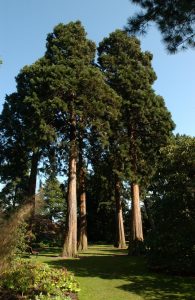The woodland garden was developed during the 1930s and 1940s, with large conifers planted to create a climate for Rhododendrons and other woodland plants which benefit from a more shaded aspect.
A striking feature of this area is the John Muir Grove, a circle of Sierra Redwoods (Sequoiadendron gigantea). They were planted in the 1920s, and now stand over 24m high. This area is now a popular choice for weddings and other commemorative ceremonies.
The shelter provided by the established tree canopy has allowed Rhododendrons, in particular large leaved species from the lush forests on the lower slopes of the Himalayas, to flourish. The woodland garden continues behind the Caledonian Hall, further plantings of Rhododendron provide a wonderful display from late February through to early summer. Primula, Hosta, Trillium and Anenome also thrive in this area. During June and July the vibrant blue of the Himalyan poppy (Meconopsis) forms a beautiful display.
Within the Woodland Garden are the Peat Walls. These were originally constructed in 1939, using the technique pioneered at Logan. These beds allow plants which prefer moist, acidic soils to thrive within the gardens at Inverleith, in particular the large number of ‘treasures’ being brought back by plant hunters from the Himalayas. This area has recently been renovated (2010), as a pernicious weed had become established in the beds. Plants in the Peat Walls include dwarf species of Rhododendron, Meconopsis, Trilliums and Gentians.
When these bed were originally established at Inverleith the environmental and ecological impact of the loss of Peat Bogs was not understood. RBGE now try to keep the use of peat to a minimum within its gardens, and use peat extracted from low impact sites.

